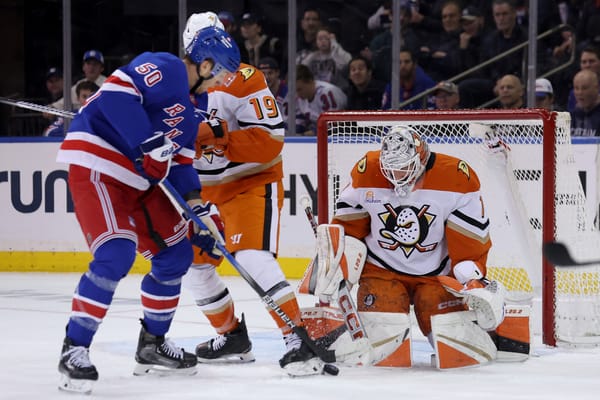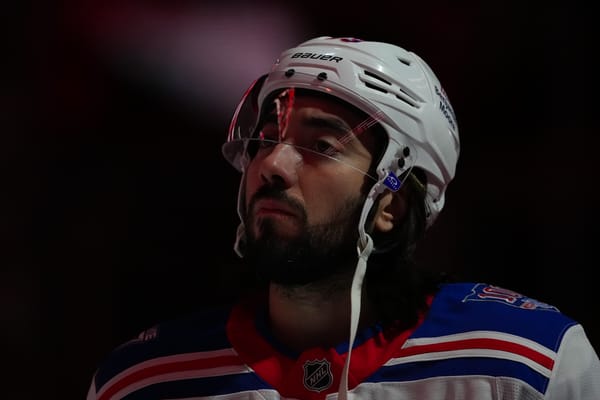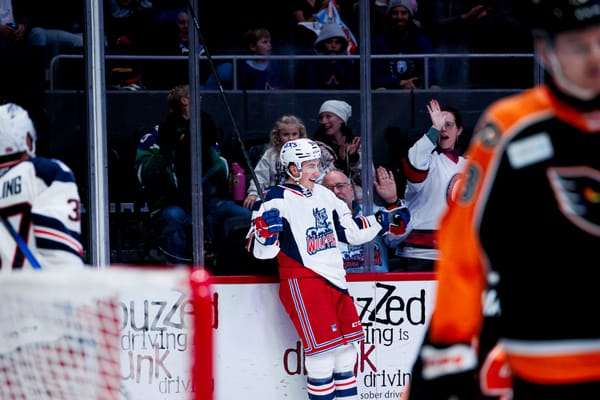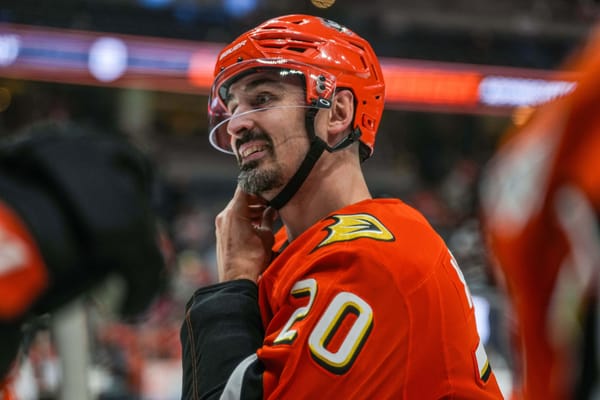What Is Next For The New York Rangers and Kevin Hayes?
In December I wrote a piece with the title, “Has Kevin Hayes Been #ActuallyGood for Rangers In 2017-18?”
Related
Has Kevin Hayes Been #ActuallyGood for Rangers In 2017-18?
It was an analytical look at the plight of Hayes, a forward who was doing a lot of good things without being rewarded for them. At the time, Hayes had just 12 points in 30 games played which a decline from the 21 points he had during the same span of time the season prior. Most of that decline was due to missed opportunities, an example below of a should be goal getting botched.
Zucc & Hayes on a 2v1 pic.twitter.com/yOaYL0w0v2
— Shayna (@hayyyshayyy) November 11, 2017
I decided to revisit that article now primarily in the wake of the J.T. Miller trade, because a topic of conversation for most of the season pinned two pending restricted free agents against each other – Hayes vs. Miller. Most of the Blueshirt Banter staff felt that the Rangers would ultimately have to choose between keeping one of the forwards, due to each’s status as an arbitration eligible restricted free agent one contract year away from free agency. Additionally, I am revisiting it because I wanted to see if my assumption at the time was right, and where he’s at overall in relation to his 2016-17 production.
With Miller out of the picture you would assume that next steps with Hayes would be simple, but it is kind of complicated. With that said, it’s time what’s next for Kevin Hayes.
Stats Update
The majority of my December piece dove into detail about Hayes’ amazing underlying numbers, especially compared to last year. Not only has Hayes continued his turnaround, but his boxcar numbers now line up with production from previous seasons.
In terms of usage, he had an offensive zone faceoff percentage of 41.17 last season, and this year that number is 42.03 according to Natural Stat Trick. In other words, Hayes is being used the same way as last year but producing better overall. For additional reference, Hayes’ numbers in that area were 60.50 and 60.92 in his first two seasons.
As of March 3 (not Saturday’s contest vs. the Edmonton Oilers), Hayes has the same amount of points than he did all of last season, and one more primary points than he did the two previous seasons. His P/60 and P1/60 are each up 39 basis points.
Hayes has also been a much better in terms of driving play, with a CF% of 46.24 vs. 43.54 last year. And the team is better with him on the ice (plus-0.56 relative Corsi), unlike last year (minus-5.82 relative Corsi). He’s also been a positive player in terms of goal scoring on his own and when compared to his peer group. The swing from minus-4.34 to plus-15.49 in terms of relative goals for is phenomenal, and the best part is that you can’t simply point to Hayes being super lucky. For context, his PDO is 102.59 vs. 102.21 last year. It is important to look at his raw totals and where they fall in comparison to previous seasons as well. This somewhat debunks the notion he only looks good because of a bad team. His raw totals are all within the same range, and there haven’t been any dramatic spikes to suggest otherwise.
All in all, Hayes certainly is proving that last year’s “struggles” at 5v5 were just a blip in an otherwise solid start to an NHL career, and there’s reason to believe this trend will continue going forward. If anything, there’s a chance Hayes could at least tie his career best number in total 5v5 points for one season if he were to go on a tear the rest of the way with increased ice time. So with that said, we all should expect Hayes to be given a nice contract extension right? Well... maybe.
Competition Down The Middle
Mika Zibanejad is currently designated as the Rangers’ No. 1 center. Unless the Blueshirts get even more drastic with their rebuild at the draft, it is hard to imagine a world where that isn’t the case next season. The No. 2 center position would then seemingly be Hayes, but things could be complicated with the addition of Vladislav Namestnikov and Ryan Spooner. Mike took a good look at Spooner, and what he could offer the Rangers here, so I will focus on Vlad.
The biggest thing that stands out is the ice time jump this season as he’s at 874 minutes in just 64 games, where he was only at 887 in 74 games last year. He’s having a career year in terms of total points (28 at 5v5) and a scoring rate of 1.92 points per 60. His P1/60 of 1.17 is also an increase over his 0.88 last season too.
How much of this was fueled from playing with Nikita Kucherov and Steven Stamkos remains to be seen. I am confident there was some impact, but the nature of that will bear itself out over time as Namestnikov plays with the Rangers.
That aside, another interesting wrinkle is the PDO differential. If anything he was unlucky last year at 99.40, and this year he’s at a fair 102.59. That number isn’t too drastic when compared to his other seasons to date, so it shouldn’t come off as a red flag.
A quick scan of his other number show him being a pretty good possession player and some fair numbers relative to his peers. He is a minus player in Rel GF% with the exception of one season, but I feel that speaks more about the other players on his team being really good than it does him being bad.
It is just a cursory scan, but the numbers tell an okay story. His primary point totals aren’t as high as Hayes’, but then again, it isn’t hard to believe that in many occasions he wasn’t the last or second to last player to touch the puck on a goal. It is important to consider that it is too soon to tell what he will do with this team, because there’s no way of knowing who he will be playing with on a regular basis.
How he fits in stylistically from a systems perspective is also an unknown, because we don’t know who the coach will be next year. Still, Namestnikov has the potential to be an integral part of the new Rangers – but will it with or without Hayes and Spooner?
What Could Happen?
There are a few options the Rangers could go with Hayes, Namestnikov and Spooner, and I will run through a few of them in the order of likelihood:
1. All Remain on Roster, Two Shift to Wing
I personally feel this the most likely option. Namestnikov was being deployed as a winger prior to joining the Rangers, and I see no reason why that wouldn’t be a good move. Spooner has been used as a winger since joining the team as well. Depth on the wing is scarce with the loss of Michael Grabner, Rick Nash and J.T. Miller, and there really aren’t viable options in Hartford. Mats Zuccarello is a player who could be moved at the draft, and if that’s the case there’s even more of a need for wingers. So in this case, Vlad and Spooner make the most sense left or right of center.
2. Two Stay, One Is Traded at The Draft
The second option is also something that could happen, because the Rangers need to rebuild their blue line. There are prospects in the system who the team has high hopes on, but no clear No. 1 to anchor the defense. It remains to be seen if Brady Skjei can be that guy as well. Given the fact that all are arbitration eligible, it wouldn’t shock me if they tried to flip one in a package for a defender. This theoretically would allow the remaining players flexibility in terms of position.
3. One Stays, Two Traded at The Draft
Pretty much everything I said for No. 2 applies here. Only difference here would be if Rangers wanted to add a defender and try and move up in draft and/or acquire another first. Either player could be a nice sweetener in the right package.
4. All Stay On Roster At Center
This is the least likely to happen, because it could block Lias Andersson and/or Filip Chytil from the roster. There’s a way to make it work, but one or both would end up in the bottom six, which is not what you want to happen. It also would block a spot that could eventually be taken by Brett Howden who should be in Hartford next season.
What I Think Should Happen
New York Rangers sign Kevin Hayes to five-year deal with an AAV of $5.5 million
Matt Cane’s model predicts that Hayes on a five-year deal is worth $4.82 million. I feel that Hayes’ actual contract ends up being somewhere between my figure and his. Maybe something like $5.25 million with some summer bonuses as a form of lockout protection. So the logical question you probably have is, why do I think Hayes is worth an AAV of $5.5 million? This deal would be make Hayes the Rangers’ highest paid forward, but it accounts for cap inflation.
When Zibanejad signed his deal which carries an AAV of $5.35 million, it represented 7.13 percent of the salary cap. He also had a stat line of 188 points in 337 games for a 0.56 points per game average. Hayes currently has 161 points in 292 games for a 0.55 points per game average. I referenced some other contract comparables in my initial story which you can check out if you’d like.
The major difference here is Hayes is a year older with less experience, so the Rangers were in a situation where they were buying UFA years. Hayes’ hypothetical $5.5 million salary would represent 7.05 percent of a $78 million cap, or 6.87 percent of an $80 million cap. I am a believer that percent of cap space occupied is more important of a metric than the actual hit when comparing two players salaries year to year.
There is also an element of accounting for the cap rising, because there needs to be an incentive for the player to lock in for a number of years, because it prevents them from maximizing their career earnings. In this case that’s why I feel the $5.5 million is a fair sell for all involved parties.
The figure isn’t unreasonable, and it would cover his age 26, 27, 28, 29 and age 30 season. Hayes would turn 31 in May of 2023. It is possible the Rangers could get him for less, but this wouldn’t really be an overpay. This contract would cover the Rangers’ rebuild, and would allow them to retain Hayes at the end of the deal as a veteran.
There is no shortage of options for the Rangers when it comes to Hayes. He is valuable as a player and an asset. It really comes down to what the Rangers are looking to do this summer, and what position they value most.
Hayes is a proven 5v5 producer, and a primary points machine. Since joining the team, Hayes is third among all Rangers in 5v5 primary points with 99 in 293 games played. Hayes has 162 career points, so that means 61.11% of his offensive production has been primary at 5v5 which is fantastic.
Mats Zuccarello finished first with 106 points in 303 games and Rick Nash second with 100 in 269 games played. He is also third among all Rangers in primary points per 60 with 1.64. Nash was No. 1 with a rate of 1.78 and Michael Grabner was No. 2 with a rate of 1.65
All of this is just to emphasize that Hayes is the type of player you want to hitch your wagon to, and hopefully the Rangers realize that this summer as they start laying down a new foundation. It would be a big mistake to play around in negotiations or move him because he’s thought of being expendable.
All stats are 5v5 adjusted via Corsica.hockey unless otherwise noted.





